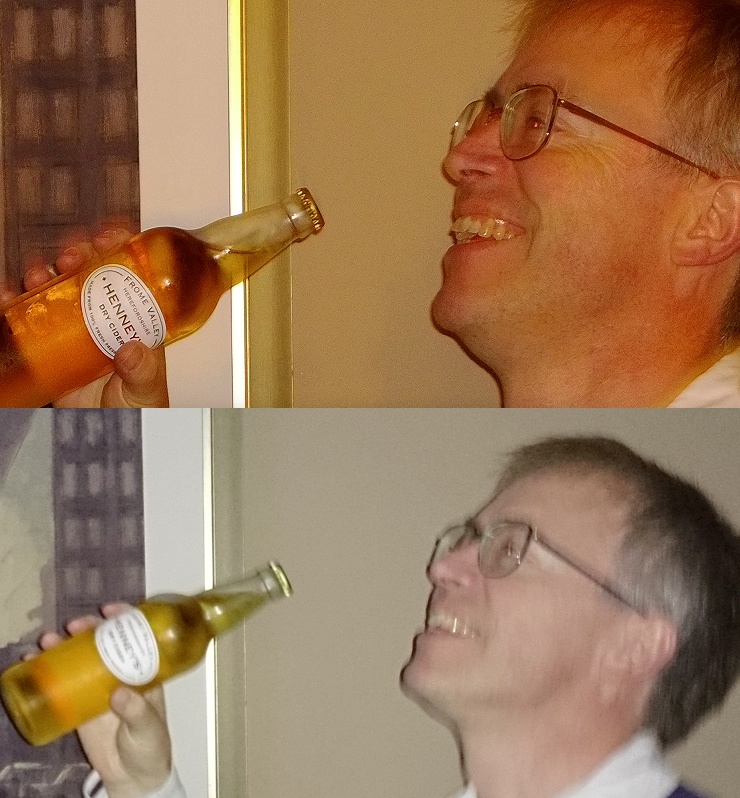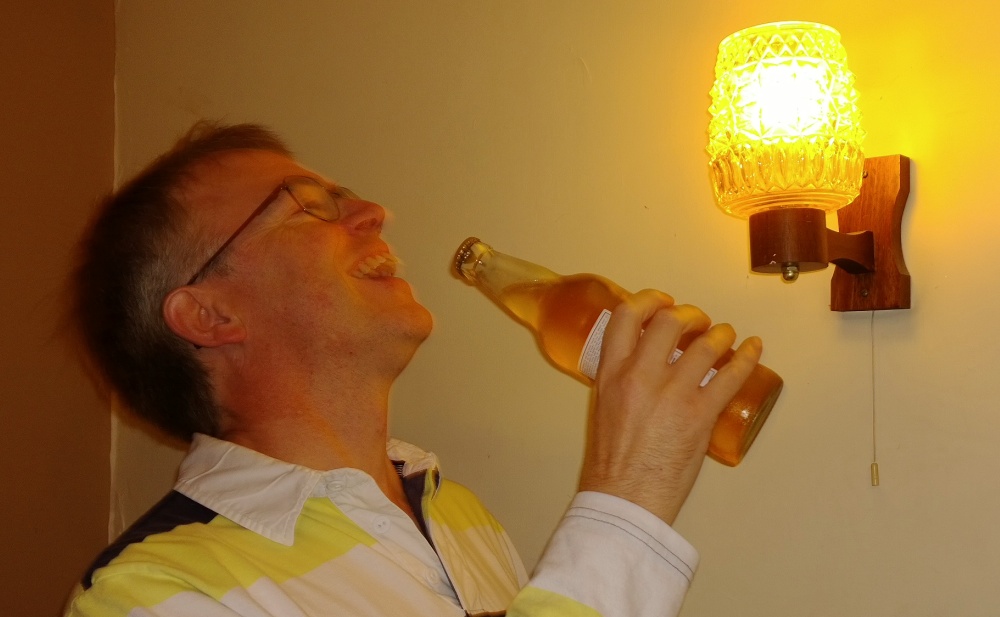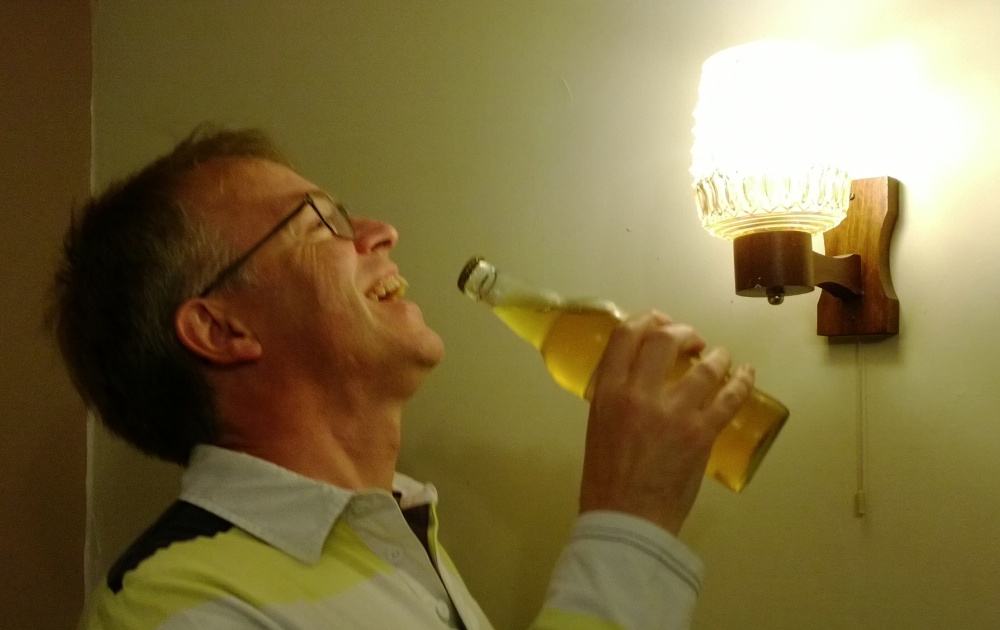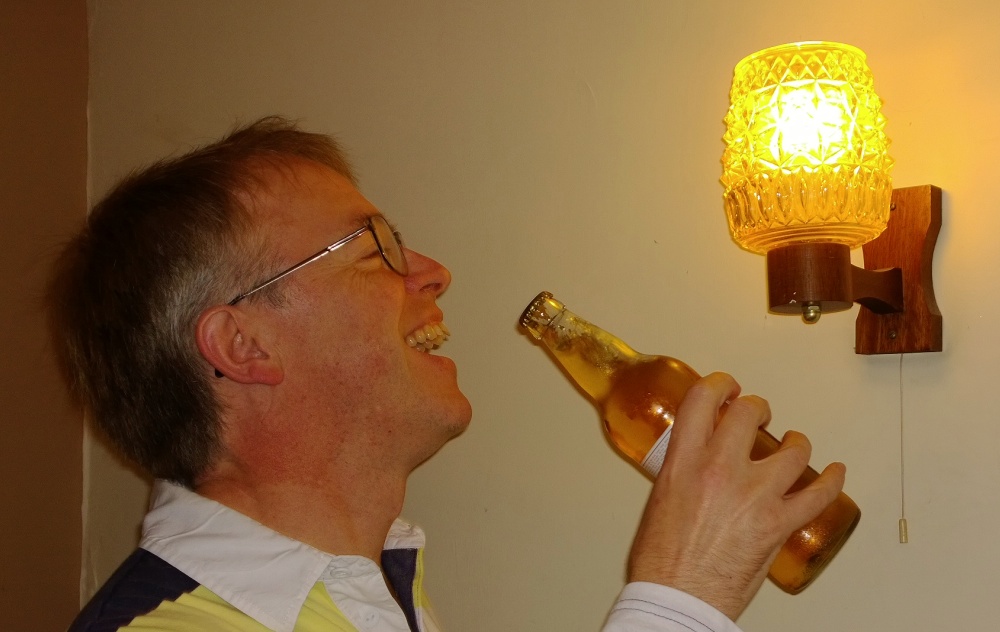When photographing people indoors and especially when the light's a bit low, almost all phone cameras struggle, of course. The low light and weak LED flashes mean that shutter times are of the order of 1/10th of a second and, with the largest aperture, any movement at all by the subjects will result in blur. You may remember my comparison between the Lumia 1020 and the Sony Xperia Z1 recently? Here's the appropriate 'party' mock-up shot, cropped in a little for effect:

The Z1's not being terrible here - in fact it's typical of all other LED flash-equipped phone cameras. The Lumia 1020, with a Xenon flash that's much brighter and also fires in a few microseconds, should in theory be able to utterly freeze the moment, even if the subject is laughing (as here) or dancing wildly.
The fact that, by default, the Lumia 1020's camera doesn't quite do this is down to the design decision mentioned earlier. A common complaint about Xenon-lit shots is that the main subjects are brightly lit, and frozen in motion, but that the background and environment is usually much darker and less obvious. In other words, the context of the photo is lost.
So Nokia, given a large aperture and BSI sensor, plus OIS, meaning that any motion from the user will be smoothed out, went for a hybrid capture approach, by default. The Xenon flash is fired, but the shutter time is allowed to stretch out to (typically) 1/30th of a second, meaning that plenty of ambient light and detail is captured as well. The only trouble is that if the subject is indeed moving significantly, you get a ghosting effect that's almost as ugly as if flash hadn't been used in the first place.
Let me illustrate the issue and suggest a solution. Here's a typical pub/party mock-up, with warm incandescent lighting and a moving subject (me putting on a laugh!) at just over a metre away from the phone camera:

This is taken with the Nokia Lumia 1020 with everything on automatic. Let's start by cropping in a little so that we can see what's going on better:

Note the (slightly orange) ghosting, seen most obviously on the tip of the nose and top teeth(!) What's happening is that the mechanical shutter is opening, light starts to be gathered from the moving subject (in this case, my head was moving backwards as I laughed) and then at some point in the 1/30s the Xenon flash gets fired, very, very briefly. This freezes motion, by definition, but the previous motion and illumination tend to leave slight ghosting.
Nokia's compromise isn't a bad one and you'd have to be moving fairly obviously to see these sorts of effects. For many people shots at events, your subjects may be still enough (especially if 'posing') that any ghosting will be negligible - and you'll benefit from plenty of ambient light, giving a better rendition of how the scene actually looked.
However, what if you're shooting people who are all moving? Maybe there's music on and they're dancing (or at least jigging about!)? Maybe you're shooting kids (who never, ever stay still if they can help it)? What if you don't mind losing some of that ambient feel if you could improve the absolute crispness of faces and bodies?
The solution, I contend, is to make use of one of Nokia Pro Camera's adjustable sliders - specifically the control second from the right, marked with a little 'timer' icon. This is the shutter speed:

Now set the shutter speed to 1/125s by swiping your right thumb down the control as needed. Don't worry that red bars might appear below some of the other settings - you'll be OK. In order to get a feel for what we're doing, tap on the left-hand flash control a few times to turn the Xenon flash 'off'. Just for a moment. Taking the same mocked up shot again gives us (again we're cropped in slightly):

Now this shot isn't ideal, since it's not perfectly crisp, but the overall motion blur has been reduced by the reduction in shutter speed (effectively around four times quicker). The Lumia 1020's sensor and aperture are powerful enough to cope, light-wise (the ISO gets increased, essentially) and the result is that, looking at details like my nose and teeth, there's almost no blur at all.
So, 1/125th of a second seems to work in terms of shutter speed, but the 1020's then right on the limit in terms of light and noise, so let's revert the Xenon flash setting back to 'Auto' and take the shot again:

Perfect - the quicker shutter speed has limited the amount of motion blur from the moving subject, the Xenon flash lights up the subject very well, keeping details crisp, while the exposure time is still long enough for some ambient lighting to creep in, helping colours look more accurate, especially for the background and light sources.
In practice
Now, it's a slight pain to have to change this one setting when taking photos at an event or occasion. Yes, it only takes a couple of second to do (tap on shutter speed, swipe to 1/125), but Nokia Pro Camera resets to defaults every time you go 'back' out of the application, so you're going to have to do it after each camera launch.
Happily, it's not as if this shutter speed reduction is essential - after all, the 1020 may still take perfectly adequate Xenon-lit photos on 'auto' - it all depends on the light levels, how much your intended subjects are moving and how badly you want to 'freeze' them in action.
The results do speak for themselves though - give it a try in your living room, club, pub or church, wherever you want to snap people in indistinct light:
- Start up Nokia Pro Camera (e.g. by long pressing on the phone's camera shutter button)
- Either tap on the shutter speed icon and then swipe up as needed, or swipe left on the main capture icon to 'fan out' all the settings and then the one you want is the second slider from the right.
1/125s seems to be about right, Choosing a shorter shutter speed will still encompass the Xenon flash, of course, so you'll still get a good photo. but you'll start losing out on any ambient lighting. Have a play and see what works for you!
